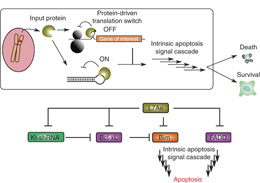Research Abstract
タンパク質に応答するRNAスイッチによる人工ヒト細胞運命調節システム
本研究では、細胞内にあるタンパク質をヒト細胞の運命調節のための引き金として使う方法について述べる。
Synthetic human cell fate regulation by protein-driven RNA switches
2011年1月18日 Nature Communications 2 : 160 doi: 10.1038/ncomms1157

細胞運命を制御する仕組みの解明は生物学、医学や工学にきわめて重要である。本研究では、細胞内にあるタンパク質をヒト細胞の運命調節のための引き金とし て使う方法について述べる。このオン/オフ型翻訳スイッチは、細胞内タンパク質L7Aeとそれに結合しているRNAモチーフからなり、任意の標的タンパク 質の発現を調節し、さらに標的ヒト細胞中の2つの異なるアポトーシス経路を制御できる。このようなスイッチを組み合わせて使い、細胞内で発現した特定のタ ンパク質が、異なる2つのmRNAの翻訳の抑制と活性化を同時に行えることを実証した。すなわち、1つのタンパク質が、2つの異なるタンパク質あるいはシ グナル経路について、一方を促進し、同時に他方を抑制することが達成できる。さらに、ゲノムにコードされた任意のタンパク質にL7Aeを付加することで、 このタンパク質の細胞での発現状況に依存して、細胞運命を2つの方向(細胞死あるいは細胞の生存)に自在にコントロールできた。この方法は、内在性のシグ ナル伝達ネットワークをバイパスあるいはリワイアリングすることで、細胞の異常修復や、有用分子の細胞内生産力の向上に利用できる可能性がある。
- 京都大学大学院生命科学研究科
- 科学技術振興機構 戦略的創造研究推進事業(ICORP)
- 京都大学 次世代研究者育成センター(白眉プロジェクト)
Understanding how to control cell fate is crucial in biology, medical science and engineering. In this study, we introduce a method that uses an intracellular protein as a trigger for regulating human cell fate. The ON/OFF translational switches, composed of an intracellular protein L7Ae and its binding RNA motif, regulate the expression of a desired target protein and control two distinct apoptosis pathways in target human cells. Combined use of the switches demonstrates that a specific protein can simultaneously repress and activate the translation of two different mRNAs: one protein achieves both up- and downregulation of two different proteins/pathways. A genome-encoded protein fused to L7Ae controlled apoptosis in both directions (death or survival) depending on its cellular expression. The method has potential for curing cellular defects or improving the intracellular production of useful molecules by bypassing or rewiring intrinsic signal networks.

